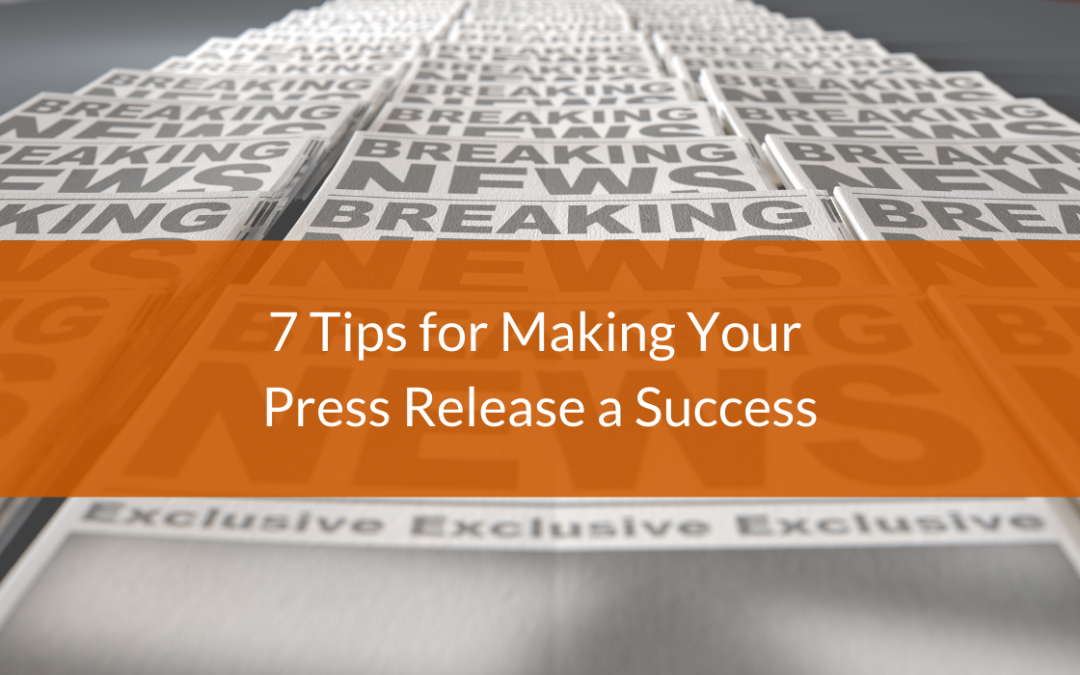
by Margaret Kelly | Nov 1, 2023 | Blog
One of my guilty pleasures is watching animal videos – because who doesn’t love otters having fun in the water or cows playing with balls? The captivating power of photos and videos should also be considered when creating a press release.
When your company wins a contract, achieves a major award or releases a new product, you might find it important enough to warrant a press release. To grab the attention of a journalist, consider adding a photo or video.
In the same way an image captures your attention on social media, an extra photo or video (an “asset” in industry jargon) in a press release will get the attention of the media. In fact, Amendola’s release partner, PR Newswire (a Cision company), reports that adding an asset to a release will increase your media coverage by 600%.
But gaining media coverage is just the start.
In the words of Bonnie Raitt, let’s give them something to talk about
A press release contains the information you want to share – but why not give readers more? By inserting a link in the release, you can take them to a landing page on your website where they can learn more. Too often, however, such links and calls to action are pushed to the last paragraph.
Best practices call for no more than three hyperlinks in any one press release. Therefore, consider linking to your corporate website only in the boilerplate and not in the first paragraph. The aim is to provide the journalist with as much information upfront as possible before they click on your website to learn more about your company and products.
As for your call to action, a picture (or video) is worth a thousand words. To maximize your reach, create a unique asset to place in the right-hand column of the press release, next to the first paragraph.
Creative assets to consider include:
- A headshot for a new hire
- An infographic or a link to the first page thumbnail for a case study.
- For an award, an image of the award or a photo of the person being awarded
- If you have won a contract, add the new partner’s logo or a photo of their headquarters
- For a new product, include a screenshot or video of the product’s dashboard.
Adding an asset to a release currently increases the cost of your release by about $400 – but the return could be great if it increases your press release impressions by 600%!
Here’s an added benefit: Once you have created these assets, you can re-use them for other marketing initiatives, such as within newsletters, reports to stockholders, social media, collateral during tradeshows, and much more.
One last tip: As soon as your press release is ready to hit the wire, upload it to the “news” page on your website. Avoid frustrating journalists (and clients and prospects) who are looking for the latest company news, only to find releases from six months ago. Instead of linking back to the PR Newswire version, load the news directly to your website to ensure readers stay on your site.
Keeping your news site fresh and your press releases captivating may earn you a thank you from the press, clients and prospects!

by Margaret Kelly | Feb 2, 2022 | Blog
A famous saying in my family is, “Our family is SO short, our family tree is a bush.” Ba dum bum.
Seriously, there are certain times when being short and sweet is right on point. Example: press release headlines.
My colleague Brandon Glenn recently wrote a blog about the 2021 State the of Press Release report from PR Newswire (a Cision company). Point 3 specifically states that for headlines, less is more. Cision recommends keeping headlines fewer than 70 characters. Not words…characters (including spaces.) Why? Email applications and Google’s search engine will cut off any text over that amount.
PR Newswire offers editors and journalists the option to subscribe to their wire service based on keywords that interest them. Subscribers are only emailed press releases with the applicable terms. Imagine how frustrating it would be if they missed relevant news because key words weren’t included in the first 70 characters of the title.
We all have a limited amount of time in our day, which is why a list of shortened titles that grab our attention is useful for helping us to decide what we will spend our valuable time reading. A clear example is the daily news feed from Becker’s Hospital Review. Not only do you see headlines comprised of just a few words, for each article you also get a one-paragraph synopsis that provides enough information to help you decide if you should open the article for a deeper dive.
Now I’m going to pick on a press release that fails to be short and sweet. Note that this is not one for our clients, but the release did make me flinch when I ran across it:
“Sandoz launches authorized generic of Narcan® (naloxone hydrochloride) Nasal Spray 4 mg in US to help reverse opioid overdose, expanding access during surge in overdose deaths”
This poor headline is 175 characters. Do we really need the generic name in the headline, as well as the dosage? Again, keep in mind that email platforms and Google will cut off after 70 characters, so all anyone will see is “Sandoz launches authorized generic of Narcan® (naloxone hydrochloride).” Journalists looking for important keywords like “opioid” and “overdose” would not see this release.
If I were writing this headline, I would say, “Sandoz unveils generic Narcan® to help surge in opioid overdose deaths.” My version is exactly 70 characters and succinctly communicates the company’s general message. The rest of the details could then be included in the sub-headline or body of the release.
A headline is meant to catch readers’ attention – and it is important to do it quickly. When it comes to writing a press release headline, remember that a short and sweet 70 characters is the magic number.

by Margaret Kelly | Mar 17, 2021 | Blog
Amendola Communications specializes in healthcare, health IT, and life sciences PR and marketing. A benefit of my employment is that my day is filled with reading interesting innovations.
I research articles for social media, locate editorial calendars from trade publications, and proof press releases before I set them up on the wire. My knowledge in the field has grown substantially over the eight years I’ve been at Amendola Communications.
It’s only in the past two years or so, however, that I’ve been able to experience these healthcare innovations on a personal level. While most of our clients are B2B, meaning businesses selling to other businesses, I’m starting to see several of the products have real meaning in my personal life.
This is a great lesson for marketers. Because the more we can see them from the patient’s side, the better we’ll be able to focus on what’s important to both patients and physicians.
Here are some of the technologies I’m pleased to say are turning out to be everything we’ve said they are.
PMDP – prescription drug monitoring programs: These programs allow my clinicians – either primary care, in the ER or in an urgent care setting – to pull in all current prescriptions from not only the large chain drug store I use, but also a compounding pharmacy for one special prescription. I’m handed a printout of medications pulled from the PMDP and I simply verify.
Electronic prescribing: I can’t remember the last time I had to take a printed prescription to the pharmacy to be filled. Physicians can simply send my prescriptions or refills electronically and I’m sent a text message when they are ready to be picked up.
Mobile health applications: Like so many Americans, I suffer from migraines. My neurologist suggested a mobile app called Migraine Buddy. It allows me to track my migraines, symptoms, medications taken, possible triggers, sleeping patterns, and much more. There are reports that I can pull to give my neurologist necessary information about the number and severity of attacks. There are so many mobile health apps out there; it’s nice when your physician works with you to identify one that not only works for you but works for them as well.
Remote patient monitoring: Not long ago, my father was in the hospital and a cardiologist gave him a heart loop monitor. It is designed to monitor the heart’s function and report it back to the cardiologist via a wi-fi transmitter kept in the bedroom. Each night while my father slept, the day’s cardiac activities were sent to the doctor’s computer. In my father’s case, it was discovered that while he slept, his heart would stop beating several times a minute. He had a pacemaker installed which regulated his heartbeat.
Telemedicine: Especially in 2020, most patients probably got to experience at least one telemedicine visit with a doctor. I used it a few times before COVID-19 as it was convenient and free of charge with my health insurance. But during 2020 and so far into the start of 2021, almost all my care providers are opting for virtual care. Indeed, the industry has seen over 8,000% growth based on insurance claims.
Patient portals: My primary physician’s group, including my neurologist, has a patient portal in which I can request an appointment, send a private message to any member of staff, or save medical documents. For me, it’s an easy way to communicate with my care givers. It’s like a secure email system and I get answers more quickly than playing phone tag.
There are even more innovations that will be coming soon. The Centers for Medical and Medicaid Services (CMS) has issued interoperability rules that will make it so hospitals and health systems, through updates from their electronic health records vendors, will allow patients to download their medical records onto their smartphones.
This was supposed to be in effect already, but physicians have enough stress handling the pandemic. So CMS is extending the deadline for the healthcare system to comply.
Reading about our clients’ innovations through bylined articles, press releases and social media is intriguing. However, it’s also exciting to be experiencing these advancements in the real world.

by Margaret Kelly | Oct 28, 2020 | Blog
Most journalists (36%) still receive their news from the good old press release. As a PR professional, you are responsible for getting the news your client wants to disseminate in front of as many relevant people as possible.
But in 2020 when the usual news topics have been turned on their head, how do you do that?
PR Newswire – a Cision company – released its State of Press Release report which noted that 48% of all releases issued between March and May 2020 mentioned COVID-19.
The report also provided these statistics when comparing 2019 and 2020 news topics:
- Future events news dropped 56%
- Trade show news releases dropped by 77%
- Public safety news increased by 192%
- Corporate social responsibility releases increased by 118%
- News about infectious disease control saw a huge jump of 3,140%
If your client’s release is either in a category that isn’t being discussed, or included in a topic that’s likely to get lost in the shuffle, how do you ensure yours stands out?
Here are seven tips to give you an edge.
1. Start at the top with a short, newsy headline. A short and catchy headline is where you capture audience attention. After all, when you scroll through a newspaper, social media platform, or newsletter, what is it that makes you decide which articles to read?
The average headline length for a press release is 88 characters. Keep headlines short and sweet, and if it’s absolutely necessary for a longer headline, ensure the important keywords are in the first 70 characters because this is where Google search engine results and email subject lines cut off.
2. Use strong call-to-action words. According to the PR Newswire / Cision State of the Press Release report, these are the top 10 CTA headline words:
- Confirms
- Reveals
- Proves
- Launches
- Empowers
- Enables
- Allows
- Announces
- Rolls Out
- Shows
3. Select the right newswire company. At our agency, we have been working with PR Newswire for many years. We have experience with all the wires, but we feel this company has an edge.
Not only do they have superior customer service, their wires syndicate to more outlets than any other. Additionally, they have a service in which editors pay to subscribe to their wires.
It gives those looking for news the chance to eliminate a mass download to their inbox, and it provides search terms. Therefore, when we set up releases to be sent on the wire, we use an option provided by PR Newswire, in which we “code” for keywords and trades. This allows the right people to find the news they are actively looking for to write into their story lines.
4. Pick the right time to send your news. According to Cision, the highest volume of news is sent at 8 AM ET, Mondays through Thursdays with Tuesday being the highest day of release traffic. 52% of copy is sent at the top or bottom of the hour.
So, to stand out from the flood of releases being pushed, yours should be sent either before or after 8 AM ET. If you’re looking to maximize your visibility, the best days are Tuesday, Wednesday, or Thursday in the middle of the day. Use odd times like 9:05 am, or 1:10 pm.
5. Make content informative and engaging. The average press release according to Cision’s data, is 686 words and readers spent 3 minutes and 39 seconds. But it won’t get read at all if it doesn’t interest the media. This blog post by my colleague Michelle Noteboom provides tips for tweaking your message to ensure the audience hears you – during COVID-19 and beyond.
6. Don’t rely on the wire alone – pitch away! Hopefully, you’re working with an experienced PR agency who has a great media relations team. I pulled this entire paragraph from Cision’s report because I found it compelling:
“For the first time in Cision’s State of the Media Report history, we asked reporters to share what days they receive pitches most and what days they actually prefer getting them. As many of us expected, Mondays proved to be the preferred day for reporters, and it was also when they got pitches most. However, many journalists reported they were still open to receiving pitches until Friday (a handful even on Saturday and Sunday). As the week progresses though, the number of pitches they receive declines. While their interest in receiving pitches did slightly decrease, the numbers weren’t so significant that it should prevent publicists from reaching out.”
7. Look outside the box for other ways to promote your news. Ensure the client is posting the release on their website. Use your social media team to create multiple, engaging posts for all the client’s social platforms. And if your client is a member or sponsor of any publication or trade organization, find out if benefits include posting corporate news.
New hire announcements, contract wins, and product launches all make for news-worthy events. In the world of health and health IT, we look to publications such as HIStalk, Answers Media and DOTmed, and trade organizations including AHIP, CHIME and the ATA for posting our clients’ press releases.
2020 hasn’t been an easy year. But with a little extra work and attention to detail, you can ensure your press release is picked up and read by as many people as possible.

by Margaret Kelly | Jul 15, 2020 | Blog
Welcome to Q3, 2020. What does that mean for how public relations and marketing departments will invest in their futures?
Q4 will be the time to finalize budgets for 2021. After a tumultuous year including a pandemic, record unemployment, civil unrest and a to-be-determined presidential election, not to mention murder hornets and whatever else the universe chooses to throw against us this year, 2021 may be a welcome sight. But with the roller coaster year we’ve had, faith in budgets may not be so faithful.
Investors will tell you that when the stock market plummets, don’t stress out thinking you’ve lost a fortune. Instead, remind yourself that stocks are now on sale. Buy while prices are at their lowest.
Channeling money back into your business is solid advice any time but especially after a difficult year. Here are five reasons why hiring a public relations firm could be the wisest decision to help you make up for lost revenue.
- Pay the pros, not the employees. Even in the healthcare world during a pandemic, health-related jobs are not secure. If your company had to reduce its staff, it’s likely support personnel including social media teams and internal communications managers may have been the first people to go. Hiring a PR firm, however, comes with all these specialists, and so many more. Fully staffed agencies have writers, SEO and content marketing pros, just to name a few, and you won’t have to pay for their unemployment insurance, 401K contributions, or health insurance premiums.
- Investors aren’t. This June article from MobiHealthNews points out that in these uncertain times, investors aren’t investing, especially in startups. Smaller companies must find other ways to get their message out, and their brand recognized until they can score a big influx of cash. An agency with a proven track record is the safest option for small companies with limited resources.
- The press release is still king. In this blog recently contributed by my colleague, Brandon Glenn, most journalists (36%) still receive their news from the good old press release. A PR firm will staff writers to get your message out there, and better still, leverage it to your target audience. And what about news wire prices? Agencies negotiate rock-bottom deals because of the number of releases they send each year, which means that’s one less contract you have to maintain. The perfect agency will also understand your niche market, so its messaging is on-point, saving you valuable time on revisions and re-reads.
- Full service or customized options. The perfect agency is also one that is full service, meaning it’s a one-stop-shop for everything from social media to revamping your website. However, if you don’t have the budget or need for all services, ask for customized options to fill the gaps in your internal marketing department. Perhaps you have a great handle on social media, but your website or collateral material is outdated. Or maybe you want to launch a new product. A great PR firm will offer guidance on how to best utilize the money in your budget.
- Uncertainty of in-person events. If there’s one thing 2020 taught us, it’s not to count on a sure thing. For the first time in 58 years, the HIMSS Annual Conference was canceled. Much to the dismay of exhibitors, HIMSS didn’t handle the monetary situation very well. Many exhibitors slated for 2020 are trying to decide if they are going to boycott in 2021. No matter your opinion on this topic, the fact is in-person events may not be happening, at least with the same attendance levels, as they have in past years. While ROI on virtual events is showing improvement, it’s even more important to consider all your options when trying to fill your sales pipeline. Having a good, established agency that specializes in your market, and who has a lot of experience and many solutions, will be important for moving forward post-COVID-19.
We may all be happy to see 2020 in the rearview mirror. But let’s not be afraid of 2021 and the opportunities it has to offer.
My brother, who is a locksmith, knows one simple truth; the months he advertises are the months his phone rings. A full-service public relations agency will know how to guide you, and help you get the most bang for your buck. Invest in your future!




